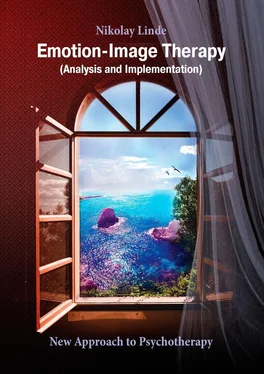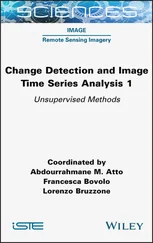Other methods of work with resistance are also possible, for instance those which are traditional in psychoanalysis and in other therapeutic modalities. For example, you can praise the client for fortitude and resourcefulness that he displayed showing his resistance. You can say that he is awarded the honorary medal “Hero of Resistance”. You can conclude an additional agreement with him: “I will gain success in therapy even if my mother [my father] and my doctor don’t like it”. After that the resistance diminishes or completely disappears.
2. Creating the hypothesis
We have already said that the whole study of images is conducted proceeding from a hypothesis, that in some way emerges in the mind of the doctor. It is necessary to pay special attention to this process as everything depends on it. How does a hypothesis appear? This is a creative process and it can’t be fully discovered. But we can explain what a hypothesis is and define some important prerequisites for it to emerge as well as the procedures of its verification.
A hypothesis is a well-grounded supposition of the consultant about mechanisms and the psychological reason, that gives rise to the client’s problem. In the course of the work the hypothesis turns into a sure knowledge.
In literature, there is practically no information about how a therapeutic hypothesis is created. It is connected with the fact that, as it was said before, it is nearly impossible to describe the creative process that leads the doctor to his guesses. Besides a hypothesis is created on the basis of this or another theory, that’s why hypotheses may be different and the process of creating them differs in different schools. However, we will try to fill this gap as much as possible, despite differences in schools.
A well-formed hypothesis contains the answers to the following questions:
– What unrealized [frustrated] desire [or attraction] of the client gives rise to the problem under study?
– What is the nature of the barrier that doesn’t let achieve the desired?
– Which conditions or events of the client’s past were conductive to the origin of the conflict?
For example, a client has the fear of water. The imagined gradual plunging into the water showed that the fear comes when the water touches her throat. It seems to the girl that the water can strangle her. To the question if anyone ever strangled her in the past she answered in the affirmative: “A man attacked me in the dark park, tried to strangle me. But some people were passing by, so he got frightened and ran away”. She is afraid of dark alleys too.
The hypothesis is obvious:
a] the frustrating need of security;
b] the barrier to feeling safe and secure is her past experience, when the client couldn’t defend herself, felt helpless and frightened. The fear materializes in the situations which, by association, make her remember the trauma [water touching her throat or dark alleys];
c] the event that caused the fixed state of fear – the attack of the maniac who tried to strangle the girl. The memories don’t come by themselves probably because they were ousted, the emotions are experienced without the realization of their connection with the initial situation.
The final check of the hypothesis happened after using the method of restructuring of the past experience. For this purpose, the client was asked to imagine herself to be strong, invincible and doing with this scoundrel all she wants. She beat him till felt fully satisfied, and he [in her imagination] didn’t run away. She felt that she was not afraid of him any longer, the imagined plunging into the water didn’t frighten her either. In her mind, she could plunge into the water not only to her throat but even with her head underwater and she didn’t have any fear. This confirms that the hypothesis and curing actions were correct.
This case is quite simple to analyze, that’s why it is given here as an example. But even here you can notice that there appear some new aspects of the hypothesis. For example, the idea is raised in what way the past experience gives rise to fear and why the client remembers only emotions and not the traumatic situation.
A hypothesis can have many additional ideas explaining:
1] in what way inner psychological conflict originates symptoms;
2] what the meaning of every symptom from the viewpoint of its place in the structure of the problem as a whole is;
3] why the client doesn’t understand some psychic phenomena;
4] in what other way the inner problem can tell on the client’s life;
5] what forms of adaptation the client uses to avoid facing the problem;
6] what he gains from the existence of the problem;
7] how the problem is connected with the character of the client of some particular features of his parents’ family and so on.
For example, if you answer points 1—4 about the previous story, you may suppose;
1] that the client has distorted relationships with men;
2] that she doesn’t only refuse to go into the water bur develops a pseudo theory that something is “happening with her head”;
3] that she has a closed character, that’s why she didn’t tell anybody about the attack;
4] that she displays a helplessness complex in other situations and so on.
You can verify these suppositions asking the client additional questions, but they may be unnecessary because the main reason is clear and the treatment has taken place.
The given example, however, doesn’t reveal the process of creating the hypothesis, you may say that it just “fell” in the hands of the doctor practically in the form of clear knowledge. So, we should reveal not only what the ideal form of a hypothesis should be but also how it is created and checked.
1. First and foremost, the basis of creating a hypothesis is a certain psychotherapeutic theory. It may be psychoanalysis, Alfred Adler’s theory [30—32], transactional analysis of Eric Berne [33—36], gestalt therapy [37—39], Victor Frankl’s logotherapy [40], and so on. Usually a doctor naturally advocates one definite concept and creates a hypothesis in the frameworks of concepts used in it. But he may use another theory most suitable to explain the given case. Such eclectic approach seems to be most sensible at present.
2. The awareness of the so called particular models facilitates the search for an adequate hypothesis. These models readymade theoretical constructions which exist in scientific psychotherapeutic world. They explain the origin of different symptoms. The doctor tries the patterns known to him to explain the phenomena he faces and chooses the one that is most suitable, checking it by asking test questions. A lot of such models are described in my book “Psychological counseling. Theory and practice” [5].
3. The knowledge of different therapeutic cases also helps the doctor. New cases may be somewhat similar to those he had in his practice before. Or it may remind those he read about in literature. Or those he watched in the work of other professionals, for example when he studied in a group.
4. His own practice of being a client in the course of the so-called learning therapy. He solves many problems by analogy with problems he solved before, using the whole arsenal of methods of the professional instructing him. Gestalt therapists joke that “the client always brings us our problem”. For that reason psychotherapy cures the psycho-therapist himself, and curing the client is a by-result. But there is more truth than humor in this joke. The doctor always applies the client’s problem to himself, if he can solve it for himself he will solve it for the client too.
5. The doctor is also helped by broad erudition, the knowledge of philosophy and religion, just great life experience, being familiar with various life collisions and people’s characters.
Читать дальше












